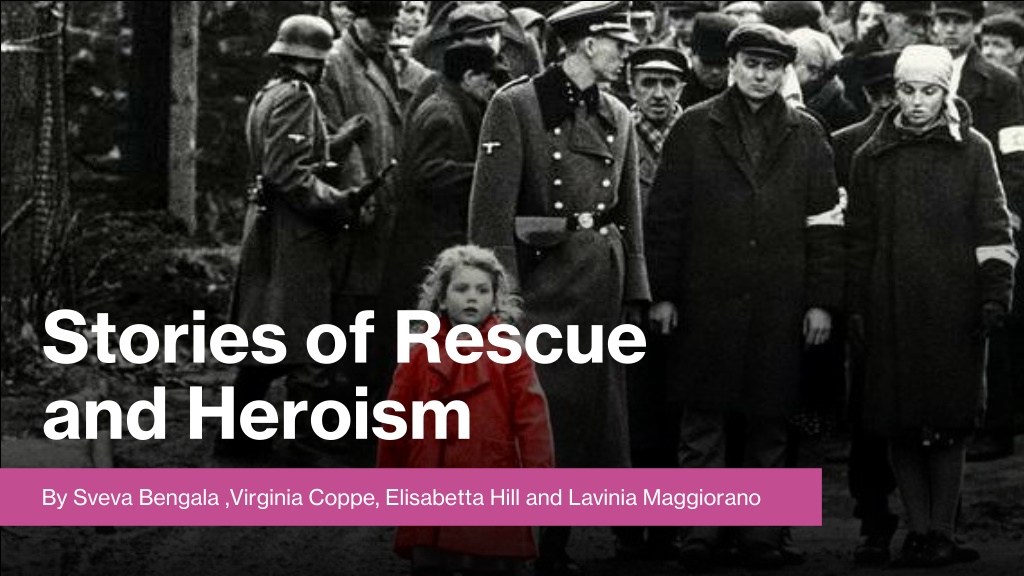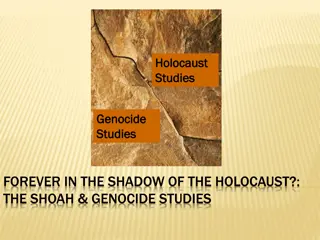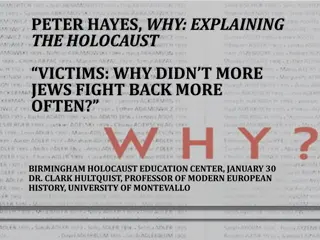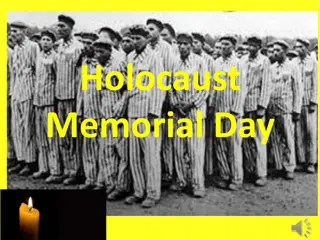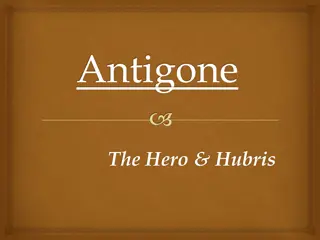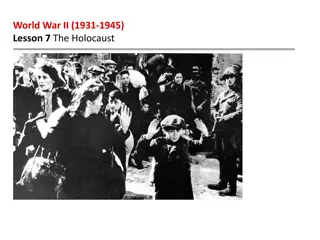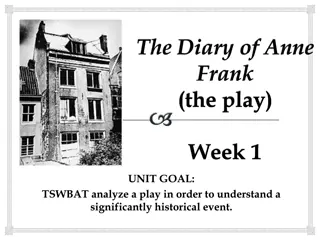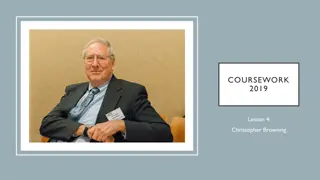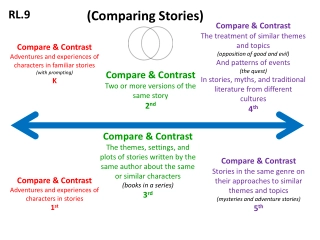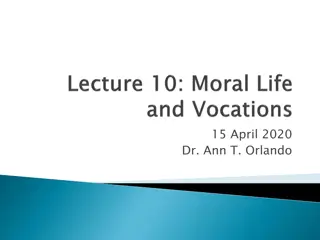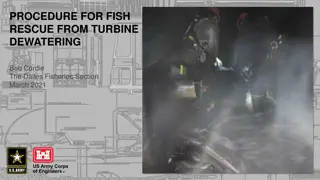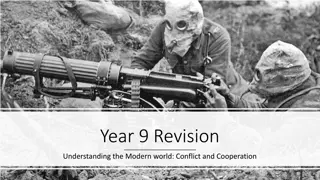Inspiring Stories of Rescue and Heroism During the Holocaust
Franceska Mann, a talented young ballerina of Jewish heritage, displayed immense courage and heroism during the Holocaust. Despite facing deportation to Auschwitz, she bravely fought against the Nazis, inspiring others to resist. Alongside other heroic individuals like Iranian diplomat Abdol Hossein Sardari, these stories of rescue and bravery serve as beacons of light in the darkest of times.
Uploaded on Oct 04, 2024 | 0 Views
Download Presentation

Please find below an Image/Link to download the presentation.
The content on the website is provided AS IS for your information and personal use only. It may not be sold, licensed, or shared on other websites without obtaining consent from the author. Download presentation by click this link. If you encounter any issues during the download, it is possible that the publisher has removed the file from their server.
E N D
Presentation Transcript
Stories of Rescue and Heroism By Sveva Bengala ,Virginia Coppe, Elisabetta Hill and Lavinia Maggiorano
Rescue and Heroism The Holocaust is a page in the book of Humanity from which we must never take away the bookmark of memory. -Primo Levi
Franceska Mann Franceska Mann, or Franciszka Mann wna, was an inspiring young ballerina of Jewish heritage. Considered a rising star in ballet, she was studying at the renowned dance school Irena Prusicka. The story of Franceska begins in the late 1940s, when the Polish-Jews of her city were getting detained in the ghetto, from where they would later be deported to the concentration camps.
Franceska Mann After being able to hide in the Aryan neighborhoods of the city for almost four years, she later sought refuge in the Hotel Polski in 1943. The Hotel Polski Affair In 1943 the Hotel Polski was used by Nazis as a ploy to trap Jews. Two Jewish collaborationists, Lolek e Adam Zuravim convinced other Jews that it would have been a safe place to stay and to buy fake passports before crossing the border and leaving the country. In reality, Jewish resistance in Warsaw tried to warn all of those that were thinking of seeking refuge there, but most of them, out of desperation, decided to hide there anyway.
Franceska Mann On 23October 1943 she was deported to Auschwitz, along with other 1700 Jews that were staying at the hotel, instead they thought they were being brought to a relocation camp, with final destination being Switzerland. When they got to the border some prisoners were supposed to go immediately to the gas chambers, including Franceska, as they were ordered to sanitize themselves in the so called changing facilities .
Franceska Mann When Franceska arrived in the changing facilities, she immediately understood that it was in fact a trap, so she was able to seduce one of the guards by dancing, she hit him with a shoe, she took his gun and she killed Josef Schillinger and wounded Wilhelm Emmerich. At that point the other women took part in the revolt against the Nazi soldiers with Franceska, unfortunately the revolt was suppressed immediately, as they were all immediately shot. This episode is proved by a German document, even if Franceska s name was not mentioned, the document refers to a ballerina, and by oral evidence.
Abdol Hossein Sardari Iranian diplomat Abdol Hossein Sardari provided critical assistance to Iranian Jews in occupied France (1940-1944). Iranian ambassador Anoushirvan Sepahbodi left for Vichy in the unoccupied zone to reconstitute the Embassy there. This left Sardari, the Consul General of Iran, in charge of consular affairs in Paris. At the beginning of World War II, about 150 Jews from Iran, Afghanistan, and Bukhara (a city in the Soviet Republic of Uzbekistan) resided in France. Following the German occupation of northern France in 1940, representatives of these three communities presented themselves to Vichy French officials and the German occupation authorities as "Jugutis . On September 27, 1940, the German occupation authorities issued an ordinance requiring all Jews residing in France to register with the police.
Abdol Hossein Sardari In October 1940, Sardari intervened in an effort to protect the Jugutis. In a letter dated October 29, he tried to convince Vichy officials, whose laws were binding in occupied France, that Jugutis were assimilated to non-Jewish Persians by culture and intermarriage and should not be considered Jews under Vichy law. Writing on letterhead for the "Imperial Consulate of Iran," Sardari affirmed: According to the study, the Jugutis of Central Asia belong to the Jewish community only by virtue of their observance of the principal rites of Judaism. By virtue of their blood, their language, and their customs, they are assimilated into the indigenous race and are of the same biological stock as their neighbors, the Persians and the Sartes (Uzbeks).
Tadeusz Pankiewicz Tadeusz Pankiewicz was an Aryan chemist who decided to stay until the end in Cracow s ghetto to help in some way the Jews that were living in the ghetto. Cracow was, along with Warsaw, one of the cities with the greatest number of Jews deported to Auschwitz. The Jews in Cracow were detained to the ghetto in March of 1941. About 17 thousand people were detained. Young people would be taken to work in factories. Suicide rates were very high among Jews in the 1940s, and most of them were battling with depression. Doctor Pankiewicz would look at all the atrocities that were being done to Jewish people from his own house. His chemist s was always open, day and night, and he would leave it open 7 days a week for whoever needed a place to seek refuge, and escape from Nazis. Many Jews and many people that were part of the Polish Resistance stopped by in his shop, looking for help.
Tadeusz Pankiewicz Many Jews began to build hiding places in the house. Some were very inventive. A family created a tiny hiding spot behind a coat hanger. The most used way out was going through sewers, infested by rats. The Nazis realized that relatively late and then, where the sewage ended at the edge of the Vistula River, they placed soldiers with guns who would fire at all those who leaned outside. Doctor Pankiewicz, with the arrival of the Soviets, had to abandon his pharmacy. In 1951 he was appointed director of all the pharmacies of the territory. A man of great culture, he witnessed several trials held in Germany. For his reputation as a savior, in 1983 he was awarded the medal of Righteous Among the Nations" and invited by the Israeli Prime Minister Ben Gurion.
Zegota In 1939 Poland was invaded by Nazis and Soviets and it was later divided in two parts. The Polish organized a real underground nation, with schools and universities, including an illegal national corps. When the Jewish persecutions first started, the Nazis were very tough on the Polish population: helping Jews was not allowed and, if someone found out they were helping Jews, the Nazis would kill the entire family of the responsible. In this environment a very important organization for Jewish people s rights and for their liberation was founded, the Zegota. The founder was a woman, a Polish writer: Zofia Kossak-Szczucka. The Zegota was able to free 2500 young kids from the ghetto. Also, they were involved in informing about the atrocities that were happening in Poland other countries, but they were not able to convince anyone, they even tried to convince Churchill and Roosevelt.
Zegota The Zegota had special departments for issues such as clothing, the wellbeing of Jewish children, medical assistance, accommodations and other important matters. It had about hundreds of cells that would provide food, medical care, money and documents. The creation and distribution of fake documents was described as one of the main tasks of the Zegota, and it is estimated that they falsified about 50.000 documents such as marriage certificates, baptism certificates, death certificates to help Jews seem Christian. During German occupation, it was illegal to hide or take care of Jews, and it was punishable with death. Nevertheless, also some Polish citizens represented a threat, as they were against the idea of helping Jews. It is widely thought that Irena Sendler once said during the war it was easier to hide a military tank under a carpet than hide a Jewish boy .
